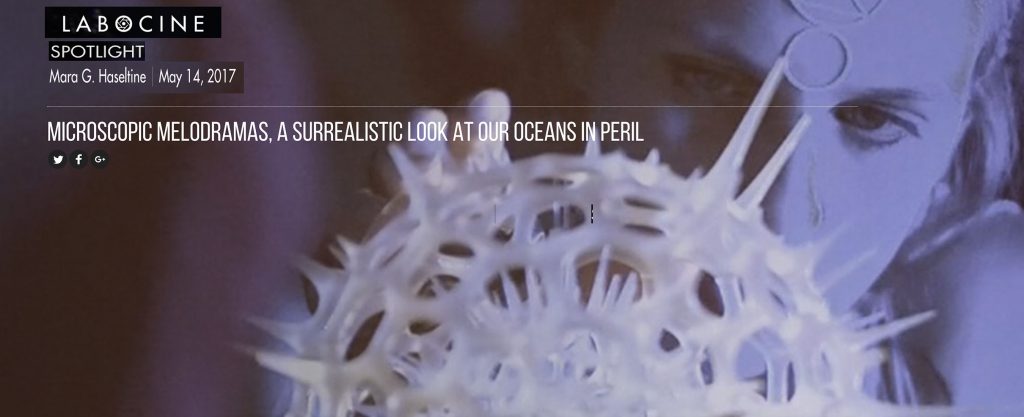
Check out my online interview with Imagine Science Films Director Alexis Gambis on “Lobocine” May 2017 a SciArt global film archive: ” Microscopic Melodramas, A Surrealistic Look at Our Oceans in Peril”.
To read article & see films goto: https://www.labocine.com/spotlight/88
Or read article below and see films in “video” section of this website
Interview Below:
Interview with artist Mara G. Haseltine conducted by Alexis Gambis, Executive Director of Imagine Science Films. Labocine features Haseltine’s films: La Bohème and Je mange la Mort pour Diner.
Cover Image: Still from live performance of “Je mange la Mort pour Diner” for the “Nocturne” Oct 31st midnight, 2015… University of Ghent, Belgium with sculpture of radiolarian plankton Skeleton performer Pelagie May Green, photo credit Jelle Jassenes.
Tell us about the two films featured here on Labocine.
Both films are meditations on what it means to be alive and existing and conscious on the planet during a mass extinction event. In both works, I strive to create a narrative that the viewer can relate to on both a megascopic and human scale and also a microscopic and biological scale. Both works stress our interdependence and role as part of the biological world as seen through the microscopic world of the oceans.
In short, we are conscious and aware of our own fragility and mortality as a species. Along with other countless other forms of flora and fauna, we are dying off at an accelerated rate due to the anthropogenic climate change …which if you really stop to think about it is a mind-boggling and intriguing time to be living through.
“Je mange la Mort pour Diner” should be seen in a perpetual loop with no beginning or end a meditation on death and incarnation and our planetary consciousness as we enter our planets’ the 6th Mass extinction event.

Above series of vertical film stills from “Je mange la Mort pour diner” where ‘GFP Caviar’ floats down to settle on coral skeleton
The phrase “Je mange la Mort pour diner” is repeated throughout the film, which is at once sensual, melancholy and empowering. I created an otherworldly set for this film in a fish tank in which I filmed glowing droplets created by infusing GFP protein from a jelly fish into small droplets of the agar rich molecular cuisine creating what I fondly call “GFP Caviar”, which fluoresce under UV light, as they fall sideways like dense snow onto the crevices of a coral skeleton. The “GFP Caviar” acts as the tiny actors in this film a homage to the bioluminescentt jellies that will float like zombies enveloping and protecting the genes for coral procreation for thousands of years. Coral has survived the last 5 mass extinctions in this jelly zombie-like state in this manner re-growing hard calciferous skeletons each time the oceans re-calibrate after a mass extinction event.

Details above from lab of “GFP Cavair” creation….the tiny actors for “Je mange La Mort pour diner”
The soundtrack for this film was a collaboration with sound artists Nils Nilsens (the voice) and Alex Snyder. It also includes extracts from the feature documentary Cells by Wil Mathijs and original sound recordings and soundscapes of the works by Martin Uit den Bogaard of decaying cells mixed with humpback whale songs.
With La Bohème, the message is perhaps much more direct and personal…where the viewer ventures into a droplet of water on a microscopic scale an acidic winter ocean. Based on Giacomo Puccini’s tragic opera, La Bohème, set in 1840′s Paris “La Bohème” depicts the poor young poet Rodolfo, who falls in love with Mimi, a young grisette who is dying of consumption. In this case, Mimi is the Tintinnid plankton sculpture ensnared in plastic riddled with dinoflagellate parasites–a representation of our ailing oceans.
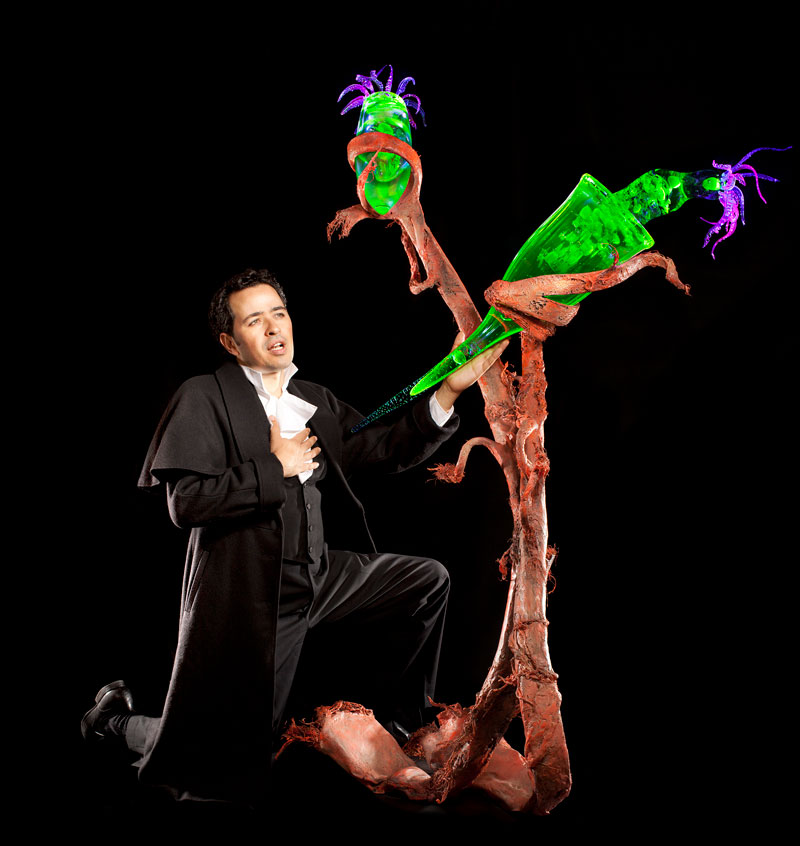
Above Still from live performance of La Bohème, the poet Rudolpho,played by Joseph Bartning, serenades Mimi a sculpture of hand blown uranium infused glass ensnared in micro degraded strand of plastic.
Who has not loved and lost? “We are all Rudolpho and we are all Mimi” is the last line of the film. It emphasizes that every living thing on the planet is linked to each other and we are in essence a large living and breathing cell floating in space.
How does the embodiment / personification of microscopic-forms in your short film, “La Boheme a Portrait of Today’s Oceans in Peril”, convey the message about climate change and endangered/polluted oceans?
Our existence and that of the microscopic world is completely intertwined especially in the case of plankton found throughout water bodies worldwide which creates at least 40% of the worlds oxygen, sequesters carbon dioxide on the ocean floor its the calcium carbonate skeletons not to mention being the basic building block of the ocean’s food chain. In essence, we depend on this exquisitely beautiful microscopic world to regulate our atmosphere without plankton we could not exist.
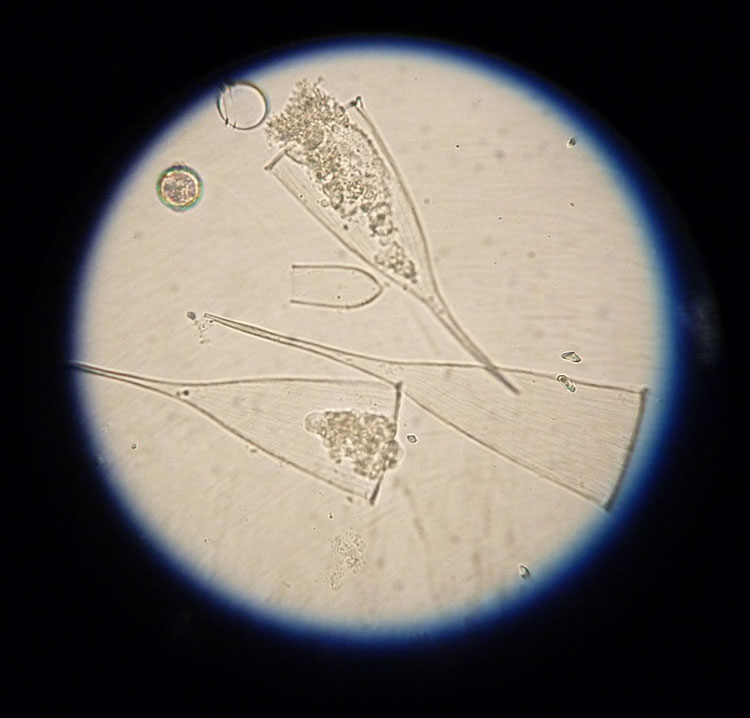
Above original image of Tintinnid plankton from specimen’s, and muse for the Mimi Sculpture I captured off the coast of Chile on the schooner Tara
The impetus for making “La Bohème: A Portrait of Our Ocean’s in Peril” came from the total heartbreak I found while looking at microscopic oceanic plankton I collected from around the world and finding microscopic strands of degraded plastic in all of my samples no matter how remote and seemingly pristine the waters were, and this was just the anthropogenic pollution visible to me through the microscope!
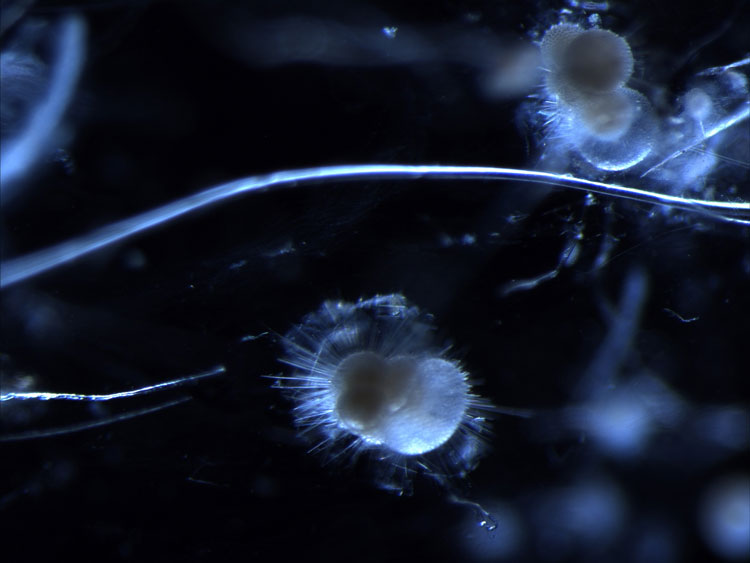
Above Microscopic Image of sample from Okinawa, Japan off Mikayojima Island where foraminifera plankton is mixed with multiple strands of micro-degraded plastic.
I wanted the viewers to be able to experience on a human scale this tragedy I saw unfolding before through the lens of the microscope.
What better way to do this than through depicting romantic heartbreak? So I chose the opera “La Bohème” by Puccini set in the 1840’s Paris in which the protagonist Mimi dies of consumption as her lover Rudolfo looks on helplessly… Mimi in this case is a sculpture of beloved plankton Tintinnid Plankton, I captured as an ‘Artist in Residence’ with Tara Expeditions off the Coast of Chile, entwined with toxic plastic and composed of hand blown uranium infused glass which fluoresces under a black light while her the charming poet Rudolph is human.
Of course, there is the surreal aspect of a grown man singing operatic arias to a giant plankton sculpture ensnared in micro degraded plastic, which creates an absurdist atmosphere to this “tale of interspecies love” which is simultaneously humorous and dark.
These films are documentations of live performances or installation bits. Do they also serve a purpose as films online or at festivals? How does the format change the experience for the viewer in your opinion?
I see all of my work as a continuum that flows from my classical training as a fine artist and sculptor. In the case of La Bohème it is meant to be a sculpture installation, live performance and film all at once. When I have all three occurring simultaneously at my opening in the agnes b. gallery in NYC in 2012 and the viewer could experience what is was like to be at that scale with the singer and witness the film all at the same time. In each format the work changes of course but I think the general feeling is the same, the viewer is transported into a world in which they themselves are the same scale as these microscopic forms creating a narrative and atmosphere that is both seductive and alien.
As an environmentalist, I wanted to be able to easily send my work to film festivals and I wanted as many people as possible to experience the message attached to the work as possible so film was an obvious choice.
As a sculptor I think of film in many ways, as an added surface texture that I can project onto objects, or layer on top of performance and this versatility is immensely appealing to me.
For the second film “Je mange Le Mort pour Diner” I have used the work both as a backdrop for live performance and also on a projected it onto a flat surface. This film is meant to be an art piece in itself seen in a perpetual loop as a cycle with no beginning or end. I am not done using this work and in fact I plan to incorporate it into more a sculptural installations.
What are you working on now and how are you influenced/driven by today’s political climate and climate change denial?
The work I make and continue to make addresses the link between our biological and cultural evolution.
I believe it is the job of artists and filmmakers to explore the times that we live in, we are the record keepers of our era. What a unique time to make work, it is time a time of transition l when the very existence of our species in the future lies in the choices that we make now.
Perhaps the utter greed and hypocrisy of ignoring and refuting climate change will accelerate the 6th mass extinction but on the bright side this struggle has mobilized people in ways I have never seen before. In addition, one must always remember the planet has always regenerated itself since its conception and who knows what new and incredible forms of life might occupy the niche that we as a species will have evacuated… Could our war-like, dominating and aggressive proprietary nature as a species in fact be an evolutionary loophole ensuring that we do not overpopulate the planet-like a built in pandemic to curb population growth? The fact that we as a species are even conscious of climate change or a mass extinction is a circumstance that to my knowledge has never before happened on our planet, and could therefore possibly be a completely unique experience. I am currently continuing my exploration through film, projection and sculpture installations to explore, educate and titillate and utilize any artistic means necessary to seduce my audience through beauty and drama on the subject of living through and documenting the fertile subject of the 6th mass extinction and perhaps help our species to evolve and harmoniously co-exist with the planet.
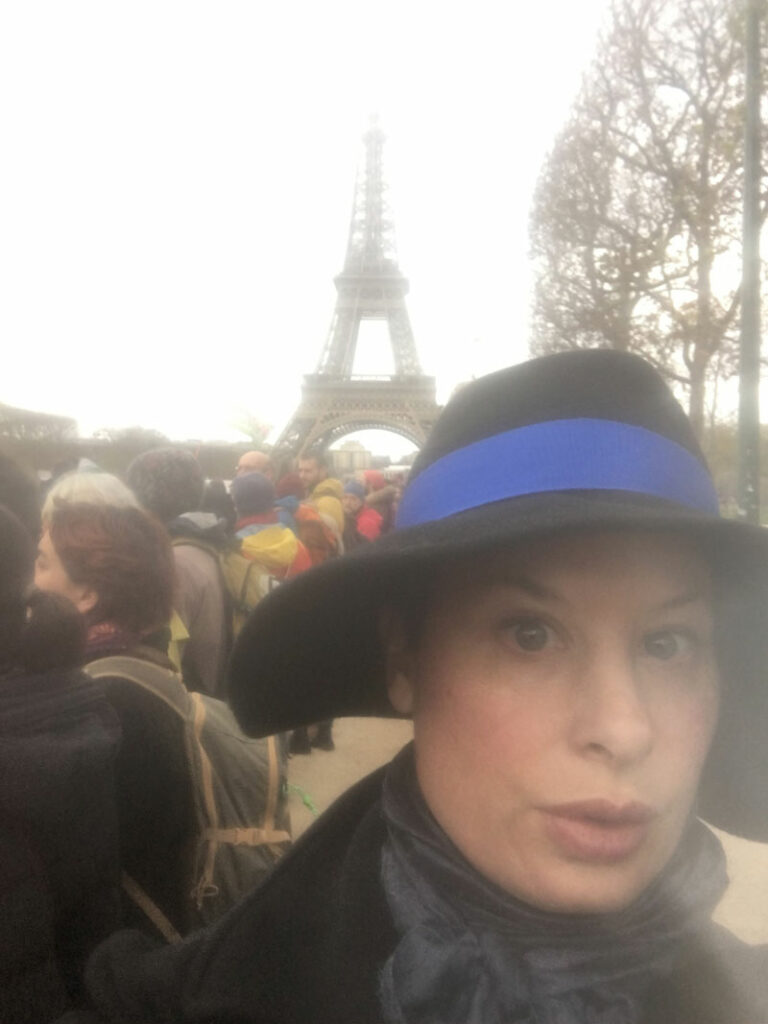
Above Image of Artist Mara G. Haseltine on Dec 12th, 2015 the final day of COP21, The Paris Climate Accord . A historic day in which all 180+ countries present including the US unanimously voted to agree to try and cap emissions to as not to exceed a 1.5 degrees c., in a united effort to curb global warming after 30 years of deliberations.
About Author
Mara G. Haseltine is an environmental artist who muse is the microscopic world she received her undergraduate degree in Studio Art and Art History from Oberlin College and her master’s degree from the San Francisco Art Institute with a double degree in New Genres and Sculpture. She has exhibited and worked throughout the United States, Canada, Europe, Asia, and at the National Museum of Trinidad and Tobago in the Port of Spain, Trinidad. She has taught at The New School in NYC, and currently teaching an art and field marine Workshop this summer in Bar Harbor, Maine and she is a member of the Sculptors Guild of NYC, The Explorer’s Club and the National Arts Club, as well as serving on numerous boards. She works out of Los Angeles, CA and Orland Maine. Her work has been published in The Times, Le Monde, The Guardian, and Architectural Record etc… To see more work and full CV please visit Haseltine’s website: www.calamara.com